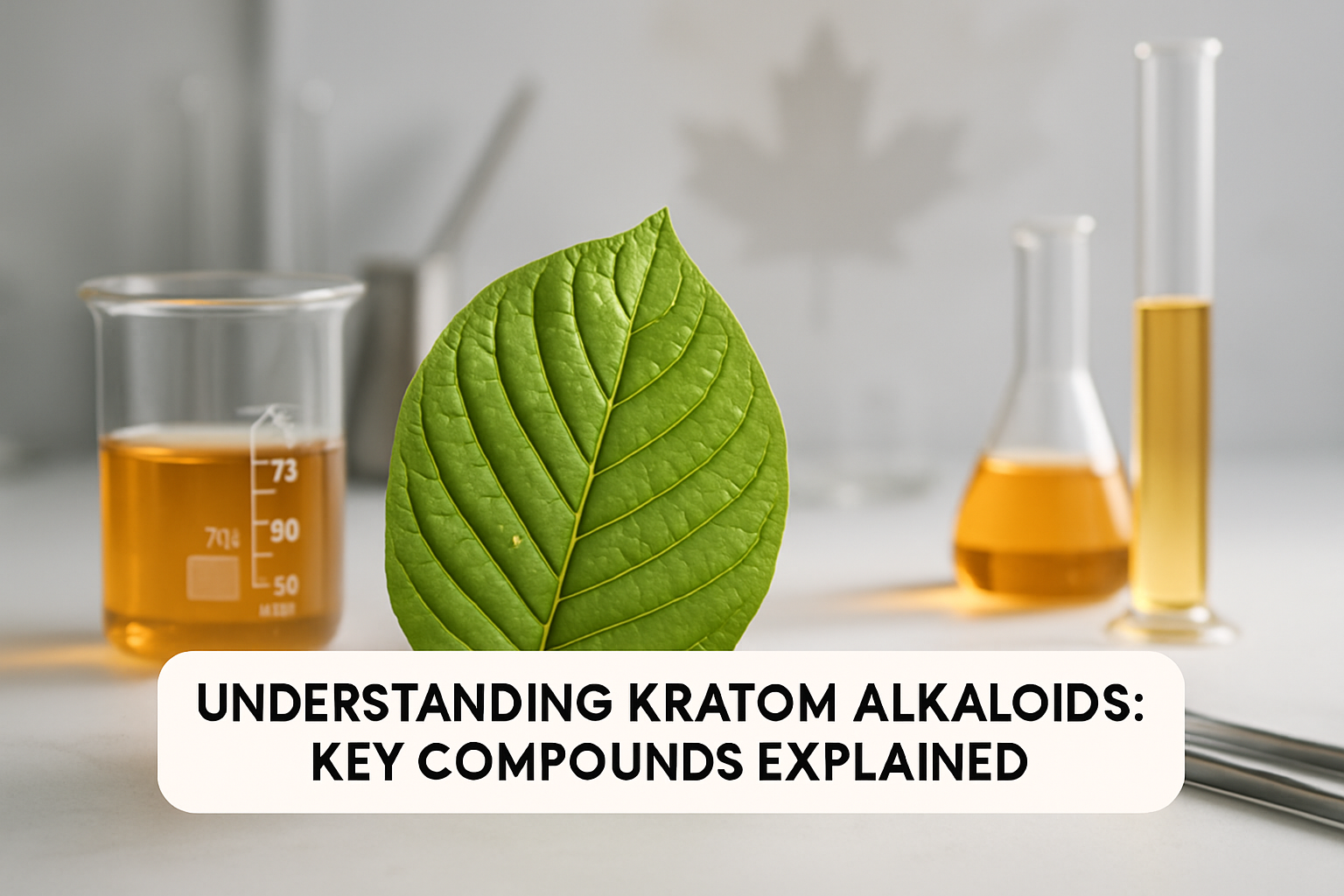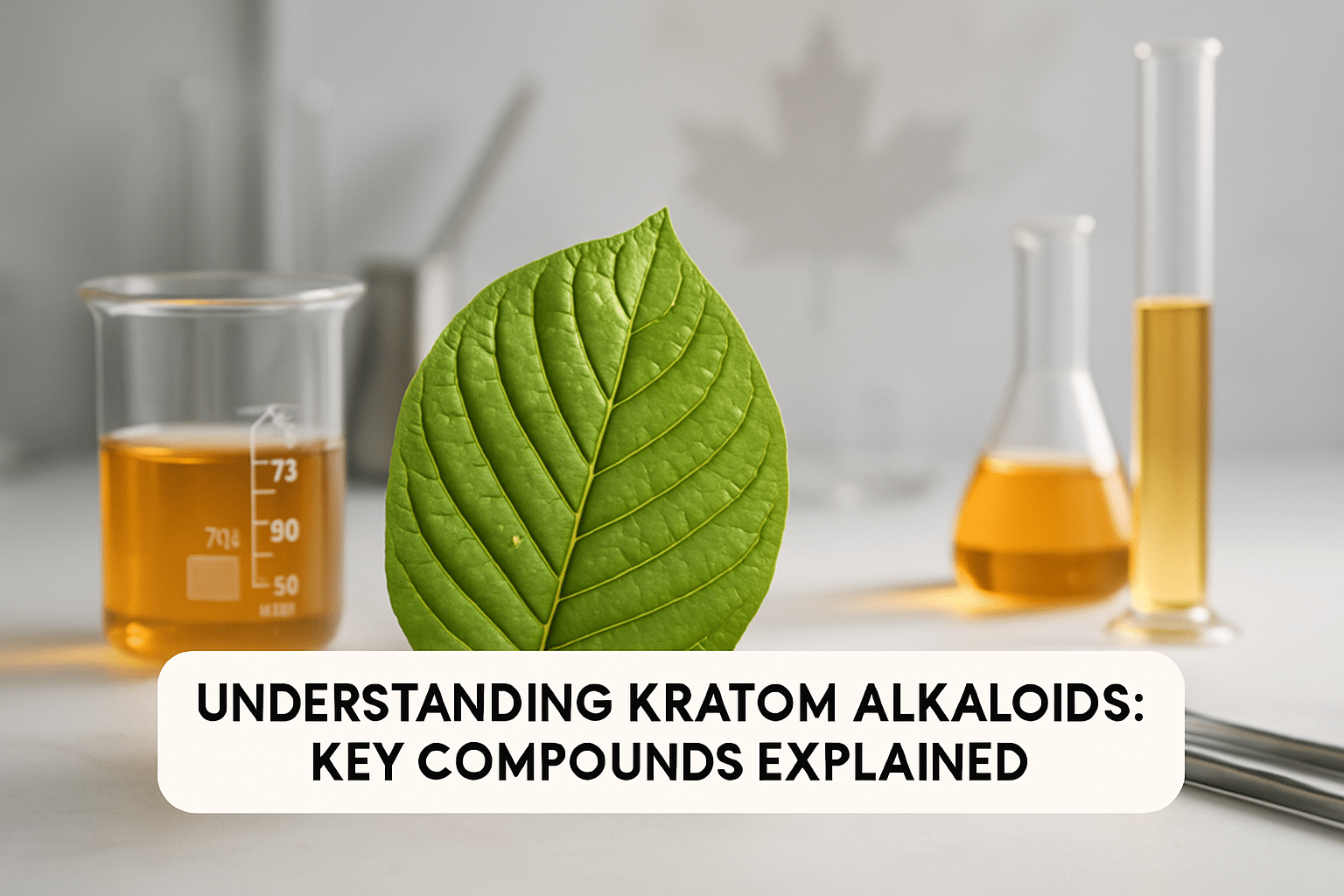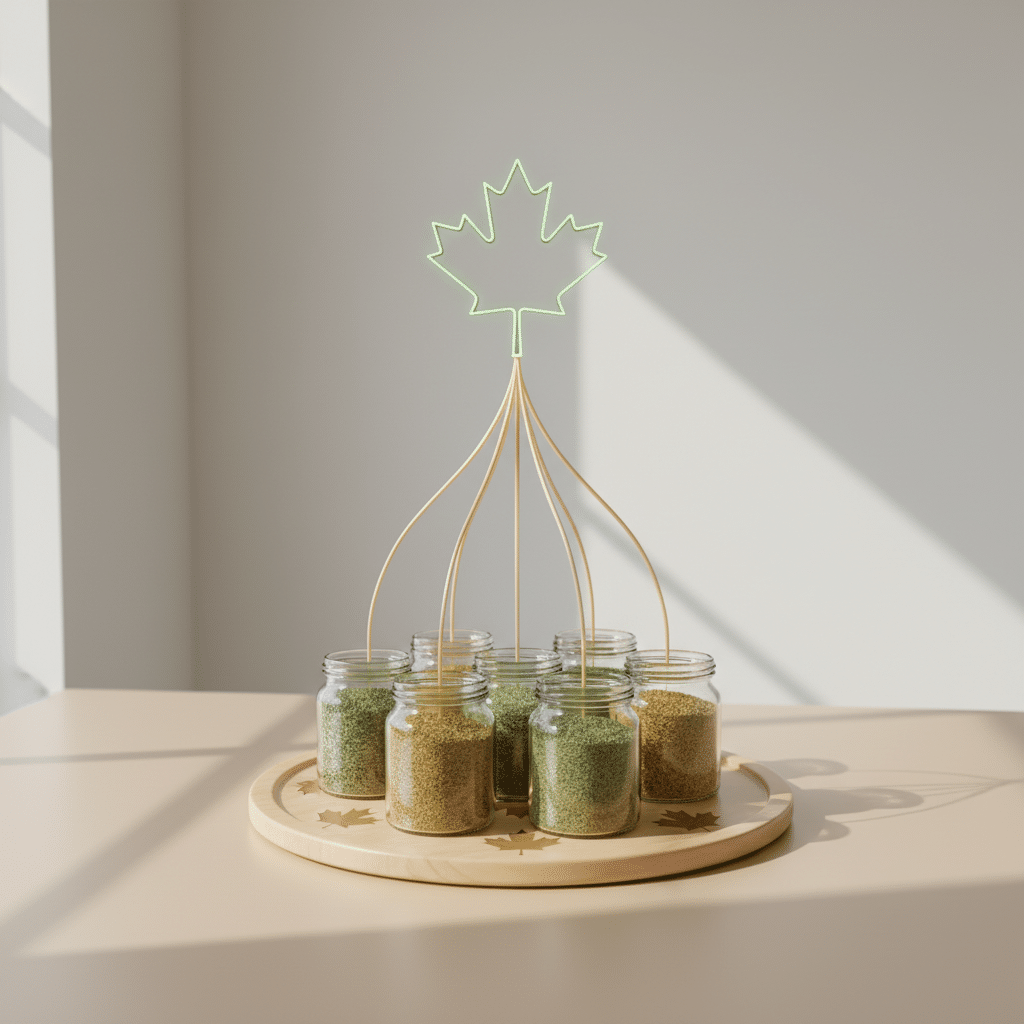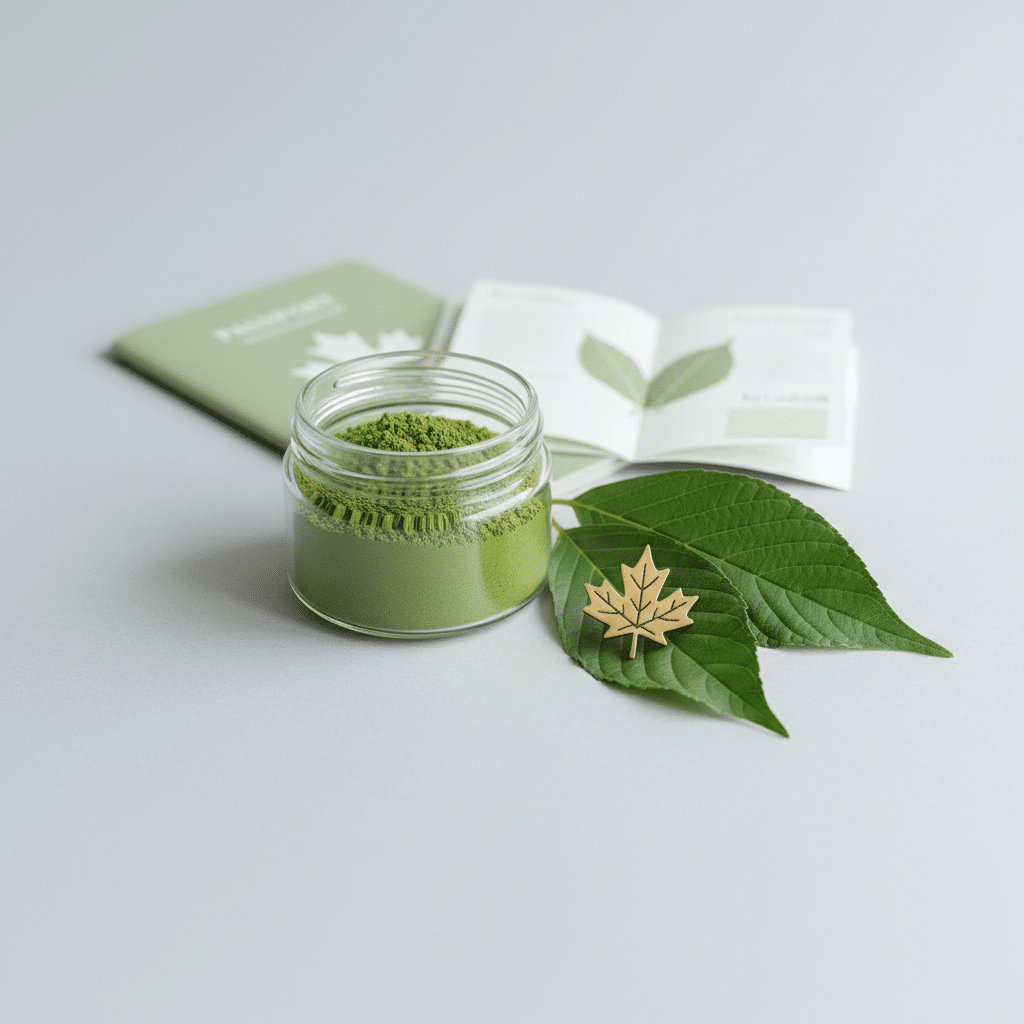
Introduction
Did you know that kratom contains over 40 distinct alkaloids, each contributing to its unique botanical profile? Understanding kratom alkaloids is essential for anyone interested in the science behind this remarkable plant. These naturally occurring compounds determine everything from potency to the specific characteristics of different kratom varieties.
Kratom alkaloids represent the core chemical constituents that make this Southeast Asian plant so fascinating to researchers and enthusiasts alike. These compounds interact with various biological pathways and receptors, creating the complex profile that has captured scientific attention worldwide. For Canadian consumers seeking quality kratom products, understanding these alkaloids becomes crucial for making informed decisions about botanical research and examination purposes.
The alkaloid content varies significantly between strains, harvest times, and processing methods. This variation explains why different kratom products can have such distinct characteristics and why proper testing and verification remain essential for quality assurance.
Primary Kratom Alkaloids and Their Properties
Mitragynine: The Most Abundant Alkaloid
Mitragynine stands as the dominant compound in kratom’s alkaloid profile. Research indicates that mitragynine constitutes over 70% of total alkaloids found in most kratom varieties. This primary alkaloid serves as the foundation for kratom’s characteristic properties and represents the most extensively studied component.
The molecular structure of mitragynine belongs to the indole alkaloid family. Its concentration levels fluctuate based on several factors including the plant’s maturity, growing conditions, and post-harvest processing techniques. Fresh kratom leaves typically contain the highest mitragynine concentrations.
Different kratom strains exhibit varying mitragynine levels. Red vein varieties often show different kratom alkaloid concentration patterns compared to white or green strains. This variation contributes to the distinct characteristics observed across different botanical preparations.
7-Hydroxymitragynine: Potency and Concentration
While present in smaller quantities, 7-hydroxymitragynine demonstrates remarkable potency. Studies reveal that 7-hydroxymitragynine binds to mu-opioid receptors with greater power than morphine, highlighting its significant biological activity despite lower concentrations.
This alkaloid typically represents less than 2% of the total alkaloid content in fresh kratom leaves. However, certain processing methods can influence its concentration. The kratom 7-hydroxymitragynine benefits become apparent when examining its interaction with various receptor systems.
Understanding the kratom mitragynine vs 7-hydroxymitragynine relationship proves essential for comprehending how these compounds work synergistically. While mitragynine provides the bulk of alkaloid content, 7-hydroxymitragynine contributes disproportionate potency relative to its concentration.
Paynantheine and Speciogynine: Supporting Compounds
Beyond the two primary alkaloids, kratom contains numerous supporting compounds that contribute to its overall profile. Research shows that paynantheine constitutes 6.6-7% of total alkaloids and acts as a smooth muscle relaxant, demonstrating the importance of these secondary alkaloids.
Speciogynine represents another significant alkaloid, typically comprising 6-7% of the total alkaloid content. These compounds work alongside mitragynine and 7-hydroxymitragynine to create the complete alkaloid spectrum that defines each kratom variety.
Other notable alkaloids include ajmalicine, corynantheidine, and mitraciliatine. Each contributes unique properties to the overall botanical profile. The presence and concentration of these supporting alkaloids help explain the subtle differences between various strains and processing methods.
The Science Behind Kratom Alkaloid Interactions
Synergistic Effects and the Entourage Phenomenon
Kratom alkaloids don’t function in isolation. Instead, they work together through complex interactions that researchers refer to as the entourage effect. This phenomenon suggests that the combined action of multiple alkaloids produces effects that differ from individual compounds acting alone.
The kratom alkaloid metabolism process involves multiple pathways within biological systems. These metabolic routes can influence how different alkaloids interact and their overall bioavailability. Understanding these processes helps explain why whole-plant extracts often behave differently than isolated compounds.
Recent studies focus on how various alkaloids modulate each other’s activity. For example, some alkaloids may enhance the bioavailability of others, while different compounds might extend or modify the duration of effects. This complex interplay creates the unique fingerprint of each kratom variety.
How Processing Methods Affect Alkaloid Preservation
Post-harvest processing significantly impacts kratom alkaloid profiles. Research indicates that harvest time and drying methods significantly influence 7-hydroxymitragynine levels, emphasizing the importance of proper handling techniques.
Traditional drying methods, such as sun-drying versus indoor drying, can alter alkaloid concentrations. Heat exposure, humidity levels, and drying duration all play crucial roles in maintaining alkaloid integrity. Some processing techniques may actually increase certain alkaloid levels through natural conversion processes.
Storage conditions also affect kratom alkaloid stability factors. Exposure to light, air, and moisture can degrade sensitive alkaloids over time. Proper storage in cool, dark, and dry conditions helps preserve the original alkaloid profile that defines each product’s characteristics.
|
Processing Factor |
Impact on Alkaloids |
Recommended Approach |
|---|---|---|
|
Drying Method |
Affects 7-OH levels |
Controlled temperature, low humidity |
|
Storage Temperature |
Influences stability |
Cool, consistent conditions |
|
Light Exposure |
Causes degradation |
Dark storage containers |
|
Air Exposure |
Oxidation effects |
Vacuum-sealed packaging |
Quality Testing and Alkaloid Verification
Laboratory Analysis Methods for Alkaloid Detection
Modern alkaloid analysis relies on sophisticated testing methods to ensure accuracy and reliability. Advanced techniques including 1H/13C NMR spectroscopy and HRESIMS are standard for alkaloid identification, providing precise chemical fingerprinting of kratom products.
High-Performance Liquid Chromatography (HPLC) represents the gold standard for kratom alkaloid lab testing methods. This technique separates individual alkaloids and quantifies their concentrations with remarkable precision. HPLC analysis can detect even trace amounts of various compounds within complex botanical matrices.
Mass spectrometry often accompanies HPLC testing to provide additional confirmation of alkaloid identity. This combination approach ensures accurate identification and quantification of both major and minor alkaloids present in kratom samples.
Importance of Third-Party Testing in Canada
Canadian consumers benefit from rigorous testing standards that verify alkaloid content and purity. Third-party laboratories provide independent verification of product quality, ensuring that published alkaloid profiles accurately reflect the actual content.
Kratom alkaloid testing methods in Canada follow strict protocols designed to detect contamination, verify alkaloid concentrations, and confirm product authenticity. These comprehensive tests screen for heavy metals, microbials, and residual solvents alongside alkaloid analysis.
Reputable suppliers invest in regular batch testing to maintain consistency across their product lines. This commitment to quality control helps Canadian consumers access reliable, well-characterized kratom products for their botanical research and examination needs.
Companies like 365 Kratom Canada prioritize comprehensive testing for all their products. Their commitment to transparency means each batch undergoes thorough alkaloid verification before reaching customers, ensuring consistent quality and potency across their entire product range.
Understanding Test Results and Certificates of Analysis
Learning to interpret alkaloid test results empowers consumers to make informed decisions about kratom products. Certificates of Analysis (COAs) typically display alkaloid concentrations as percentages or milligrams per gram of plant material.
Total alkaloid content usually ranges from 1-3% in quality kratom products, with mitragynine comprising the majority of this percentage. Understanding these numbers helps consumers evaluate product potency and consistency between different batches or suppliers.
COAs should include testing dates, methodology used, and laboratory accreditation information. This documentation provides transparency and allows consumers to verify the reliability of testing procedures used for alkaloid analysis.
Factors Influencing Alkaloid Content
Strain Variations and Alkaloid Profiles
Different kratom strains exhibit distinct alkaloid signatures that contribute to their unique characteristics. Red vein varieties often show different kratom alkaloid concentration in red vein compared to white or green strains, reflecting the impact of processing and leaf maturity on final alkaloid profiles.
White vein kratom typically contains higher mitragynine levels with lower 7-hydroxymitragynine concentrations. This alkaloid distribution contributes to the energizing characteristics associated with white vein varieties. Green vein strains usually fall somewhere between red and white varieties in terms of alkaloid composition.
Regional variations also influence alkaloid content. Kratom from different geographical areas can show significant differences in alkaloid profiles, even within the same strain category. Soil composition, climate conditions, and local cultivation practices all contribute to these variations.
Environmental and Cultivation Factors
Growing conditions significantly impact kratom alkaloid development. Factors such as soil pH, rainfall patterns, temperature fluctuations, and sunlight exposure all influence the plant’s alkaloid production. Plants grown in their native Southeast Asian environment often exhibit different profiles compared to those cultivated elsewhere.
Leaf age at harvest represents another critical factor. Younger leaves typically contain different alkaloid ratios compared to mature leaves. Traditional harvesting practices recognize these differences and select leaves at specific maturity stages to achieve desired alkaloid profiles.
Seasonal variations can affect alkaloid concentrations throughout the year. Some research suggests that kratom plants produce varying alkaloid levels in response to environmental stressors, rainfall patterns, and seasonal changes in their native habitat.
FAQs
What are the main kratom alkaloids and their concentrations?
The primary kratom alkaloids include mitragynine (70%+ of total alkaloids), 7-hydroxymitragynine (<2%), paynantheine (6-7%), and speciogynine (6-7%). These four compounds represent the majority of kratom's alkaloid content, with over 40 additional minor alkaloids contributing to the complete profile.



